新概念英语 时态大全
新概念英语前90课时态小结
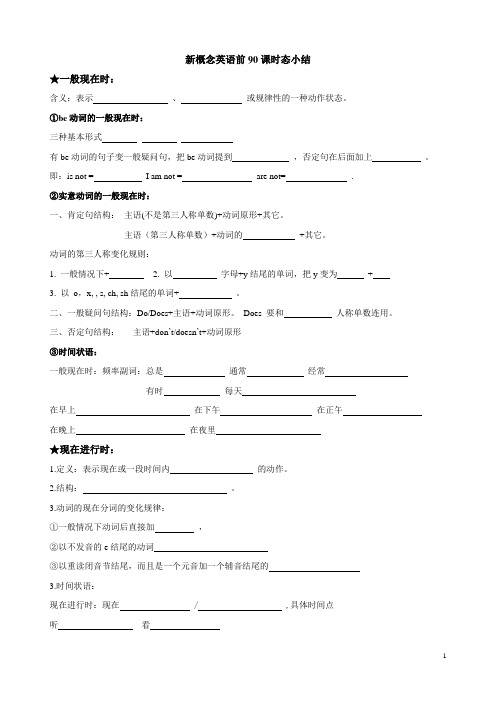
新概念英语前90课时态小结★一般现在时:含义:表示、或规律性的一种动作状态。
①be动词的一般现在时:三种基本形式有be动词的句子变一般疑问句,把be动词提到,否定句在后面加上。
即:is not = I am not = are not= .②实意动词的一般现在时:一、肯定句结构:主语(不是第三人称单数)+动词原形+其它。
主语(第三人称单数)+动词的+其它。
动词的第三人称变化规则:1. 一般情况下+2. 以字母+y结尾的单词,把y变为+3. 以o,x, , s, ch, sh结尾的单词+ 。
二、一般疑问句结构:Do/Does+主语+动词原形。
Does 要和人称单数连用。
三、否定句结构:主语+don’t/doesn’t+动词原形③时间状语:一般现在时:频率副词:总是通常经常有时每天在早上在下午在正午在晚上在夜里★现在进行时:1.定义:表示现在或一段时间内的动作。
2.结构:。
3.动词的现在分词的变化规律:①一般情况下动词后直接加,②以不发音的e结尾的动词③以重读闭音节结尾,而且是一个元音加一个辅音结尾的3.时间状语:现在进行时:现在 / ,具体时间点听看★be going to 结构1.定义:be going to+动词原形表示时态。
2.意思为:。
可以和tomorrow(明天)next…等这些时间状语连用。
★一般过去时:一般过去时:用来表示发生的动作或存在的状态。
一、be 动词的过去时现在过去Be (单数)(复数)二、实意动词的的过去时动词过去式的常见变化规则:(规则变化)1. 一般情况下直接加look- answer- clean-2. 以不发音的e结尾的动词,直接加。
arrive- telephone-3. 辅音字母+y结尾的动词,把y变为再加。
study- empty- .4. 重读闭音节结尾加辅音字母的单词,双写再加stop-不规则变化(动词过去式和原形不同)do - , say-几种常见句型:1. 肯定句:主语+动词的+其它。
(完整版)新概念英语时态讲解及练习题(五种时态)

五种时态讲解及练习题英语的时态(tense)是一种动词形式,不同的时态用以表示不同的时间与方式。
下面就英语中常见的八种基本时态进行阐述,其它的时态都是在这八种时态的基础上结合而成的。
一、一般现在时:1.概念:经常、反复发生的动作或行为及现在的某种状况。
2.时间状语:always, usually, often, sometimes, every week (day, year, month...), once a we ek, on Sundays,3.基本结构:动词原形(如主语为第三人称单数,动词上要加(e)S)4.否定形式:am/is/are+not;此时态的谓语动词若为行为动词,则在其前加don't,如主语为第三人称单数,则用doesn't,通常还原行为动词。
5.一般疑问句:把be动词放于句首;用助动词do提问,如主语为第三人称单数,则用doe s,同时,还原行为动词。
6.例句:It seldom snows here.He is always ready to help others.Action speaks louder than words.1.I like ____________ (swim).2.He _________(read) English every day.3.We _________(go)to school at seven in the morning.4.Mike________(go)to school at seven in the morning.5.My mother________(like) ______(go) shopping.6.I can ________(draw) many beautiful pictures.7.She_________(make) a model plane.8.Do you ________(like)_________(run)?9.Does he_________(like)_________(jump) ?10.Does Nancy_________(grow)flowers on Saturday ?11.The teachers________(like)___________(dance).12.The teacher________(like)____________(dance).2)用所给的人称改写句子1.I take photos on Sunday. ( Mike)2.We grow beautiful flowers. (she)3.They like collecting stamps. (Ben)4.I listen to music carefully. (my aunt)5.You like making a model ship. (Helen二、一般过去时:1.概念:过去某个时间里发生的动作或状态;过去习惯性、经常性的动作、行为。
新概念第一册语法-时态
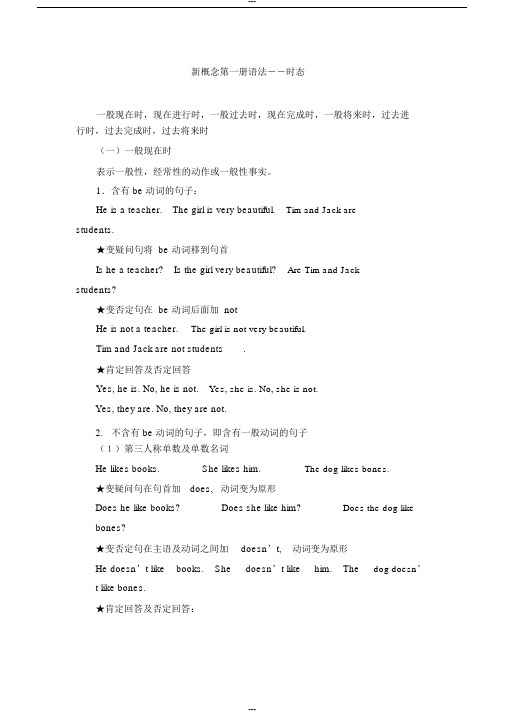
新概念第一册语法――时态一般现在时,现在进行时,一般过去时,现在完成时,一般将来时,过去进行时,过去完成时,过去将来时(一)一般现在时表示一般性,经常性的动作或一般性事实。
1.含有 be 动词的句子:He is a teacher. The girl is very beautiful.Tim and Jack arestudents.★变疑问句将 be 动词移到句首Is he a teacher? Is the girl very beautiful?Are Tim and Jackstudents?★变否定句在 be 动词后面加 notHe is not a teacher.The girl is not very beautiful.Tim and Jack are not students.★肯定回答及否定回答Yes, he is. No, he is not.Yes, she is. No, she is not.Yes, they are. No, they are not.2.不含有 be 动词的句子,即含有一般动词的句子(1)第三人称单数及单数名词He likes books.She likes him.The dog likes bones.★变疑问句在句首加does,动词变为原形Does he like books?Does she like him?Does the dog like bones?★变否定句在主语及动词之间加doesn’t,动词变为原形He doesn’t like books. She doesn’t like him. The dog doesn’t like bones.★肯定回答及否定回答:Yes, he does. No, he doesn’t.Yes, she does. No, she doesn’tYes, it does. No, it doesn’t.注意:第三人称单数形式一般在动词后面加S,不要和名词复数混淆,变否定句或疑问句时名词复数没有任何变化。
新概念英语第一册时态总结+练习
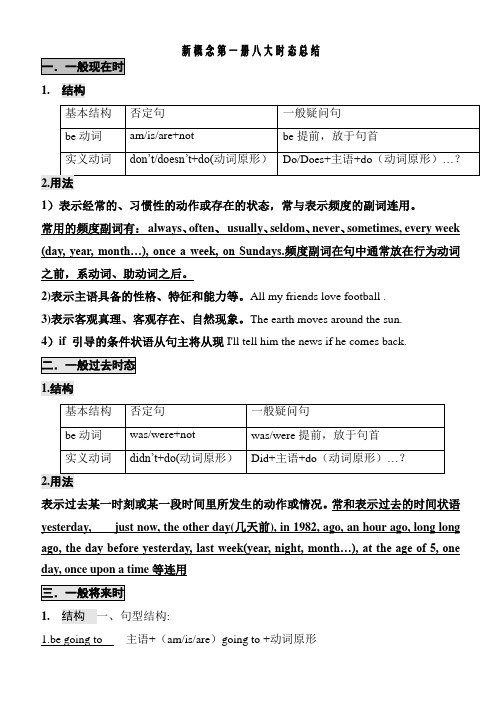
新概念第一册八大时态总结一.一般现在时1.结构基本结构否定句一般疑问句be动词am/is/are+not be提前,放于句首实义动词don’t/doesn’t+do(动词原形)Do/Does+主语+do(动词原形)…?2.用法1)表示经常的、习惯性的动作或存在的状态,常与表示频度的副词连用。
常用的频度副词有:always、often、usually、seldom、never、sometimes, every week (day, year, month…), once a week, on Sundays.频度副词在句中通常放在行为动词之前,系动词、助动词之后。
2)表示主语具备的性格、特征和能力等。
All my friends love football .3)表示客观真理、客观存在、自然现象。
The earth moves around the sun.4)if 引导的条件状语从句主将从现I'll tell him the news if he comes back.二.一般过去时态1.结构基本结构否定句一般疑问句be动词was/were+not was/were提前,放于句首实义动词didn’t+do(动词原形)Did+主语+do(动词原形)…?2.用法表示过去某一时刻或某一段时间里所发生的动作或情况。
常和表示过去的时间状语yesterday, just now, the other day(几天前), in 1982, ago, an hour ago, long long ago, the day before yesterday, last week(year, night, month…), at the age of 5, one day, once upon a time等连用三.一般将来时1.结构一、句型结构:1.be going to 主语+(am/is/are)going to +动词原形2.will :主语+will+动词原形(will为助动词,与情态动词用法相同,与动词原形构成谓语,不需要根据人称进行变化。
新概念英语八种时态一览表
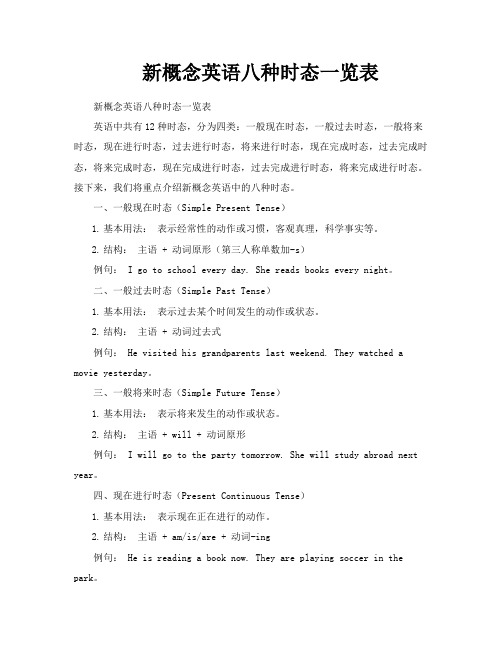
新概念英语八种时态一览表新概念英语八种时态一览表英语中共有12种时态,分为四类:一般现在时态,一般过去时态,一般将来时态,现在进行时态,过去进行时态,将来进行时态,现在完成时态,过去完成时态,将来完成时态,现在完成进行时态,过去完成进行时态,将来完成进行时态。
接下来,我们将重点介绍新概念英语中的八种时态。
一、一般现在时态(Simple Present Tense)1.基本用法:表示经常性的动作或习惯,客观真理,科学事实等。
2.结构:主语 + 动词原形(第三人称单数加-s)例句: I go to school every day. She reads books every night。
二、一般过去时态(Simple Past Tense)1.基本用法:表示过去某个时间发生的动作或状态。
2.结构:主语 + 动词过去式例句: He visited his grandparents last weekend. They watched a movie yesterday。
三、一般将来时态(Simple Future Tense)1.基本用法:表示将来发生的动作或状态。
2.结构:主语 + will + 动词原形例句: I will go to the party tomorrow. She will study abroad next year。
四、现在进行时态(Present Continuous Tense)1.基本用法:表示现在正在进行的动作。
2.结构:主语 + am/is/are + 动词-ing例句: He is reading a book now. They are playing soccer in the park。
五、过去进行时态(Past Continuous Tense)1.基本用法:表示过去某个时间正在进行的动作。
2.结构:主语 + was/were + 动词-ing例句: She was studying when I called her. They were watching TV at that time。
新概念英语第一册的七大时态
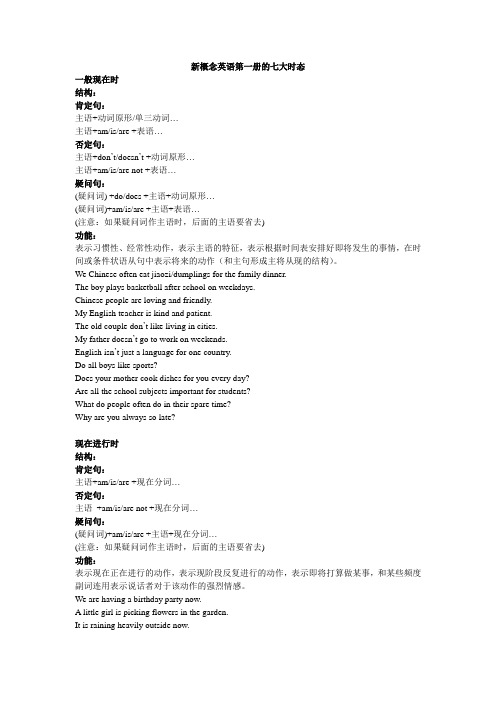
新概念英语第一册的七大时态一般现在时结构:肯定句:主语+动词原形/单三动词…主语+am/is/are +表语…否定句:主语+don’t/doesn’t +动词原形…主语+am/is/are not +表语…疑问句:(疑问词) +do/does +主语+动词原形…(疑问词)+am/is/are +主语+表语…(注意:如果疑问词作主语时,后面的主语要省去)功能:表示习惯性、经常性动作,表示主语的特征,表示根据时间表安排好即将发生的事情,在时间或条件状语从句中表示将来的动作(和主句形成主将从现的结构)。
We Chinese often eat jiaozi/dumplings for the family dinner.The boy plays basketball after school on weekdays.Chinese people are loving and friendly.My English teacher is kind and patient.The old couple don’t like living in cities.My father doesn’t go to work on weekends.English isn’t just a language for one country.Do all boys like sports?Does your mother cook dishes for you every day?Are all the school subjects important for students?What do people often do in their spare time?Why are you always so late?现在进行时结构:肯定句:主语+am/is/are +现在分词…否定句:主语+am/is/are not +现在分词…疑问句:(疑问词)+am/is/are +主语+现在分词…(注意:如果疑问词作主语时,后面的主语要省去)功能:表示现在正在进行的动作,表示现阶段反复进行的动作,表示即将打算做某事,和某些频度副词连用表示说话者对于该动作的强烈情感。
新概念第二册语法知识点汇总
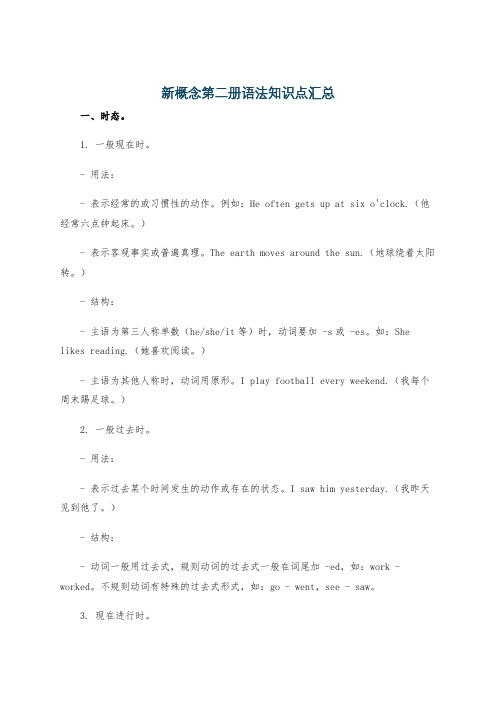
新概念第二册语法知识点汇总一、时态。
1. 一般现在时。
- 用法:- 表示经常的或习惯性的动作。
例如:He often gets up at six o'clock.(他经常六点钟起床。
)- 表示客观事实或普遍真理。
The earth moves around the sun.(地球绕着太阳转。
)- 结构:- 主语为第三人称单数(he/she/it等)时,动词要加 -s或 -es。
如:She likes reading.(她喜欢阅读。
)- 主语为其他人称时,动词用原形。
I play football every weekend.(我每个周末踢足球。
)2. 一般过去时。
- 用法:- 表示过去某个时间发生的动作或存在的状态。
I saw him yesterday.(我昨天见到他了。
)- 结构:- 动词一般用过去式,规则动词的过去式一般在词尾加 -ed,如:work - worked。
不规则动词有特殊的过去式形式,如:go - went,see - saw。
3. 现在进行时。
- 表示现在正在进行的动作。
Look! She is dancing.(看!她正在跳舞。
)- 结构:- be动词(am/is/are)+动词的 -ing形式。
He is reading a book.(他正在读一本书。
)4. 过去进行时。
- 用法:- 表示过去某个时刻或某段时间正在进行的动作。
At that time yesterday, I was doing my homework.(昨天那个时候,我正在做家庭作业。
)- 结构:- was/were+动词的 -ing形式。
They were playing football at threeo'clock yesterday afternoon.(他们昨天下午三点正在踢足球。
)5. 现在完成时。
- 用法:- 表示过去发生的动作对现在造成的影响或结果。
I have lost my key.(我把钥匙丢了。
新概念前100课时态语法总结及练习

新概念前100课时态语法总结一般现在时A:一般现在时结构:1)be动词的第一人称单数为,第三人称单数为,其他人称为。
有一顺口溜体现了它的用法:我用am ,你用are ,is 用于他,她,它, 单数is,复数are.肯定式:主语+ am /is/are +其他否定式:主语+ am/is/are +not + 其他疑问式:Am /Is /Are + 主语+ 其他?简略回答: (肯) Yes,主语+ am/ is /are(否) No,主语+ am /is/are not缩写形式: I'm that's we'rewhat's they're isn'tyou're who's where's he'sshe's it's aren't2)行为动词(实义动词)除主语是第三人称单数外,都用动词原形,主语是第三人称单数时,在动词词尾加-s或-es 。
肯定式:主语+动词原形/动词的第三人称单数否定式:主语+助动词don't/doesn't +动词原形+其他疑问式:Do/Does+主语+动词原形+其他简略回答:(肯)Yes,主语+do/does (否)No,主语+do/does not缩写形式: don't doesn't注意:“动词第三人称单数”的加法即“如何从动词原形变为第三人称单数”1、一般情况加s.2、以o, s, x, ch, sh 结尾加es.3、以“辅音字母+y”结尾,改y为i +es练习一写出下列动词的第三人称单数:study play go comehelp teach lie listenbegin open sit washguess eat run relaxB一般现在时用法经常性或习惯性的动作,常与表示频度的时间状语连用。
时间状语:always, usually, often, frequently, sometimes, hardly, never, every day (week, year, month/), once a week, on Sundays, etc.现在进行时现在进行时表示目前或目前阶段正在进行的动作。
新概念知识点总结

新概念知识点总结时态:1. 一般现在时定义:表示经常发生的动作或经常存在的状态,常和always,often,usually,sometimes,every day,等频率副词连用。
表示客观事实,亦用一般现在时。
动词用一般现在时,原型,第三人称单数形式。
句子中含有am,is,are,can,等词,变否定句,在后面加not,变疑问句,提前,用yes,no,回答。
句子中含有其他动词,用助动词do,does,对句子提问和否定,助动词后面的动词要恢复动词原型。
2. 现在进行时定义:表示说话人的说话时刻正在进行的动作,可与now,at present,at this moment,these days,等时间状语连用,也可不用时间状语。
还可以表示,一段时间内,经常重复的动作,此外,还可以用进行时表将来,例如:the bus is coming。
汽车要来了。
句型结构:am is are +动词ing形式。
变否定句,在am is are 后加not。
变疑问句,把am is are 提前,句号变问号。
3. 一般过去时定义:常表示过去某一段时间所发生的动作或存在的状态。
常和表示过去的时间状语连用,如a minute ago,yesterday,last week,in 1990,during the night,in those days等。
句子中,动词用过去式,用did 进行提问和否定,did 后动词恢复动词原型。
4. 一般将来时定义;表示将来要发生的事,或按计划,约定要发生的事。
常和表示将来的时间状语连用,如tomorrow,next week,next month,next year,in a few days等,也可以和now,today,tonight’等时间词连用。
句型结构:1. 主语+will+动词原型,否定在will 后加not,疑问把will 提前2. 主语+be going to +动词原型,否定在be 后加not,疑问把be 提前5.现在完成时定义:1.动作发生在过去,但对现在有影响或结果,后面常常不用时间状语,与already,yet,just,never,ever等词连用。
新概念英语第三册语法汇总和习题
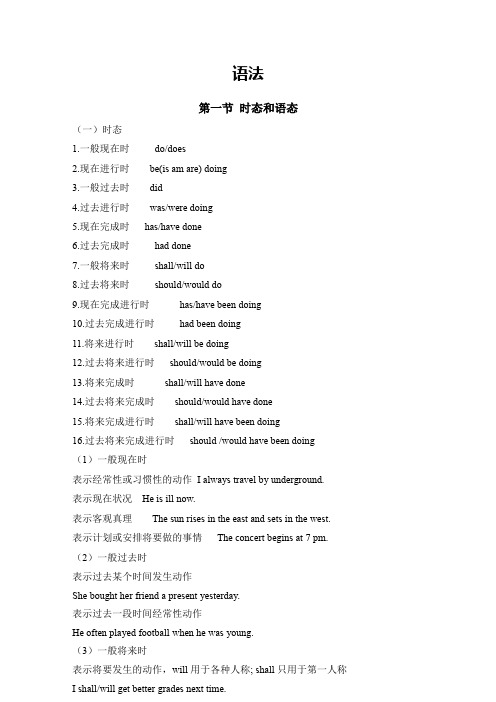
语法第一节时态和语态(一)时态1.一般现在时do/does2.现在进行时be(is am are) doing3.一般过去时did4.过去进行时was/were doing5.现在完成时has/have done6.过去完成时had done7.一般将来时shall/will do8.过去将来时should/would do9.现在完成进行时has/have been doing10.过去完成进行时had been doing11.将来进行时shall/will be doing12.过去将来进行时should/would be doing13.将来完成时shall/will have done14.过去将来完成时should/would have done15.将来完成进行时shall/will have been doing16.过去将来完成进行时should /would have been doing(1)一般现在时表示经常性或习惯性的动作I always travel by underground.表示现在状况He is ill now.表示客观真理The sun rises in the east and sets in the west.表示计划或安排将要做的事情The concert begins at 7 pm.(2)一般过去时表示过去某个时间发生动作She bought her friend a present yesterday.表示过去一段时间经常性动作He often played football when he was young.(3)一般将来时表示将要发生的动作,will用于各种人称; shall只用于第一人称I shall/will get better grades next time.Your parents will be glad to hear that you return home."am / is / are going to+动词原形”用来表示事先考虑过的将要发生的动作Jean is going to meet me at the airport.”be doing”表示根据现在计划或安排做某事I am taking Jane out of dinner tonight.be+(about) to do, 表示近期内要做的事情注意:不能与时间状语连用The new school year is about to start.难点:主将从现时间状语从句:when, whenever, since, till, once, as soon as, while, as ,before, afterI will be an English teacher when I grow up.条件状语从句:if, unless, as long as, so long asIf I have extra money, I will pay the bill for you.(4)现在进行时目前在做的动作He is studying physics very hard these days.现阶段在进行动作I hear you are writing a novel.与always, forever, constantly,continually表达有感情色彩的词汇He is forever asking silly questions like a stupid guy.(5)过去进行时过去某个时刻正在进行动作We were taking photos on the mountains.过去某段时间内的动作I was talking about the new book yesterday morning.(6)将来进行时将来某个时刻正在进行动作When I get home, my mother will be cooking dinner.计划将来要发生的事情She will be studying French at college this time next year.(7)现在完成时已经完成某事,过去的动作对现在有影响We have just e back from the United States.表示过去某一行为持续到现在,可能继续持续下去They have been best mates since school.have been to 曾去过某地,现在已经不在have gone to 已经去了某地,现在可能还在去的路上My father has been to Beijing.My father has gone to Beijing.固定句型:It is the+序数词+time that sb have/has done sth“这是某人第几次去......”It is the first time that his painting has been displayed to the public.(8)过去完成时“过去的过去”:过去某个时间开始一直延续到过去另一个时间的动作I had read half of the book by yesterday.By the time they finished the job, we had reached more.固定句型:It was the+序数词+time that sb had done sth“这是某人第几次去......”It was the second time that I had met the same kind of problem.固定句型:no sooner+过去完成时+than+一般过去时hardly+过去完成时+when+一般过去时scarcely+过去完成时+when+一般过去时“一......就......”They had no sooner reached the office than it began to rain.=They had hardly reached the office when it began to rain.=They had scarcely reached the office when it began to rain.表示过去未曾实现的愿望,与动词intend, mean, plan, hope, wish, want, think, expect 连用I had meant to e ,but something happened.(9)现在完成进行时过去某一时间开始持续到现在,并且继续持续下去I have been waiting for an hour, but he still hasn’t turned up.(10)将来完成时表示将来某时刻之前或某动作前已经发生的动作We shall/wiil have met that manager by next Monday.表示一个持续到将来某时之前或某动作发生之前的动作By next Monday, she will have studied here for three years.(11)过去完成进行时过去某个时间或动作之前一直进行的动作He had been writing this novel up to that time.(12)过去将来时:过去某事看将来要发生的动作John said he would have a rest the next day.(二)语态(1)英语语态:主动语态、被动语态He opened the door. 他打开了这扇门。
新概念英语八种时态一览表

新概念英语八种时态一览表八种时态介绍:一、一般现在时态:表示现在经常发生或习惯性的动作。
时间状语:every …, sometimes, always, never, often, usually等。
1.由be的is am are表示,之后接名词,形容词或介词。
陈述句:I am an office worker. He is so lazy. They are at home now.否定句: I am not Tim. She is not very beauiful. They are not in the office.一般疑问句:Are you an office assistant? Is she beautiful?特殊疑问句:What is your job? What colour is your bag?Where are you now?2.由实意动词V构成,引导疑问句和否定句,用do或don’t。
第三人称时用does或doesn’t,有does 出现动词用原形;第三人称陈述句V后加s或es.陈述句:I work in Shanghai. He works at home.Davy never watches TV at home.否定句: I don’t like the food in KFC. Davy doesn’t like the food in KFC either.一般疑问句: Do you want a cup of coffee? Does she live near the subway station?特殊疑问句:What do you want? Where does she live? How do they go to work?3.由情态动词can, must, may构成。
may没有否定形式。
陈述句: I can drive a car. He must tell the truth. We may get there on foot.否定句:I can’t swim at all. You mustn’t(表示禁止) smoke in the office.一般疑问句: Can you wait a minute? Must I stay at home? May I use your phone?特殊疑问句: How can I get there? What must I do now?二、一般过去时态。
(完整word)新概念一册各种时态总结,推荐文档

现在进行时:现在进行时表示说话时正在进行或发生的动作,也可表示当前一段时间内的活动。
1. 结构:主语+ be (is/am/are) + 动词ing + 其他PS: be动词要根据前面的主语变化(she/he/it is) (I am)(you/we/they are)例:我正在打篮球I am playing basketball.2. 否定句:主语+ be (is/am/are) + not + 动词ing + 其他例:我没有在打篮球I am not playing basketball.3. 一般疑问句:be (is/am/are) + 主语+ 动词ing + 其他?例:你正在打篮球吗?Are you playing basketball?4. 特殊疑问句:What(什么)Where(哪里)When(什么时候) + be (is/am/are) + 主语+ 动词ing + 其他?Who(谁)Why(为什么)How(怎么)例:你正在做什么?What are you doing?你正在哪里打篮球?Where are you playing basketball?你什么时候正在打篮球?When are you playing basketball?你正在见谁?Who are you meeting?你为什么在打篮球?Why are you playing basketball?你现在怎么能打篮球啊?How are you playing basketball?常搭配的时间短语:now, at the moment, at present一般现在时:1.经常性、习惯性动作(如:我每天都洗澡/他每天早上都上学)2.客观事实(如:我住在昆明/我爱中国)3.客观真理(如:太阳从东边升起/地球绕着太阳转)1.结构:1)主语(I/you/we/they)+ 动词原形+ 其他例:我住在昆明I live in Kunming.他们每天早上都去上学They go to school every morning.2)主语(单数第三人称he/she/it)+ 动词s+ 其他PS:以o结尾的动词,加es以辅音字母+y结尾的动词,改y为i加es例:他住在昆明He lives in Kunming.她每天早上都去上学She goes to school every morning.2.否定句:1)主语(I/you/we/they)+ don 't + 动词原形+ 其他例:我不住在昆明I don 't live in Kunming.他们每天早上都不去上学:They don 't go to school every morning.2)主语(单数第三人称he/she/it)+ doesn't + 动词原形+ 其他例:他不住在昆明He doesn't live in Kunming.她每天早上都不去上学She doesn't go to school every morning.3.一般疑问句:1)Do + 主语(I/you/we/they)+ 动词原形+ 其他?回答:Yes, 主语(I/you/we/they)+ do.No, 主语(I/you/we/they)+ don 't.例:你住在昆明吗?Do you live in Kunming?Yes, I do. / No, I don 't.他们每天都去上学吗?Do they go to school every day?Yes, they do. / No, they don 't.2)does + 主语(单数第三人称he/she/it)+ 动词原形+ 其他?回答:Yes, 主语(单数第三人称he/she/it)+ does.No, 主语(单数第三人称he/she/it)+ doesn't.例:他住在昆明吗?Does he live in Kunming?Yes, he does. / No, he doesn't.她每天都去上学吗?Does she go to school every day?Yes, she does. / No, she doesn't4.特殊疑问句:1)What(什么)Where(哪里)When(什么时候) + do + 主语(I/you/we/they)+ 动词原形+ 其他?Who(谁)Why(为什么)How(怎么)例:你每天早上做什么?What do you do every morning?你每天早上去哪里?Where do you go every morning?你每天什么时候去上学?When do you go to school every day?你每天都见谁?Who do you meet every day?你为什么喜欢中国?Why do you like China?你每天都怎么去上学?How do you go to school every day?2)What(什么)Where(哪里)When(什么时候) + does + 主语(单数第三人称he/she/it)+ 动词原形+ 其他?Who(谁)Why(为什么)How(怎么)例:他每天早上做什么?What does he do every morning?他每天早上去哪里?Where does he go every morning?他每天什么时候去上学?When does he go to school every day?他每天都见谁?Who does he meet every day?他为什么喜欢中国?Why does he like China?他每天都怎么去上学?How does he go to school every day?常搭配的时间:sometimes有时,often经常,usually通常,always总是,在早上:in the morning 每天早上:every morning在下午:in the afternoon 每天下午:every afternoon在傍晚:in the evening 每天傍晚:every evening在晚上:at night 每天晚上:every night每天/周/月/年:every day/week/month/year一般过去时:表示过去某个时间发生而现在已经结束的动作或存在的状态。
新概念英语第三册期末复习——时态(39张PPT)

☆be to和be going to 的用法之比较:??? be to 表示客观安排或受人指示而做某事。而be going to 则表示主观的打算或计划。例如: I am to play football tomorrow afternoon. (客观安排) I'm going to play football tomorrow afternoon. (主观安排)
1. — Look! How wonderful my car is! Oh, Jack. What are you thinking about? Don’t you like it? — I’m sorry I ______ any remark about it in time. I certainly think it’s smart. A. wasn’t making B. don’t make C. won’t make D. didn’t make2. To find the street where I lived in my childhood is no easy task because the city ______ so rapidly all these years. A. is changing B. has changed C. will have changed D. will change3. He ______ quite well, but he hasn’t had time to swim since this summer. A. will swim B. have swum C. swam D. swims4. Jimmy said that he would come to pick me up, but he ____by now. A. hasn’t turned up B. doesn’t turn up C. won’t turn up D. hadn’t turned up
新概念英语:时态结构图

现在完成进行:have/has been doing
1.延续性多次过去某一刻开始到现在:
all this morning,these few days,all night,this month,recently;since,for(状短/从);
2.表重复(终止性)buy
过去
一般过去:did sth. was/were ~
(动作早于主句动作,表原因先后)
3.未实现愿望;4.no sooner~than~Hardlywhen
过去完成进行:had been doing
1.过去时间为前提;by/before+过时
2.与表“突然”意义的when从句连用:
She had been looking at the photo for a long time when she realized it was ~.
过去
将来
一般过去将来:would/should do
1.带时状的从句或间接引语(主句谓语是过去时态);
My brother told me that he would be back on Saturday.
过去将来进行:would/should be ving
1.表计划正常发展,宾从,定从,状从和间接引语;(不表意愿和打算)
He will be wat礼貌的询问和请求。
Will you be lending me~
将来完成:shall/will have done
1.by/before+未来时状从和条状从;
2.对某一业已完成的动作或事推测;
时态总结 新概念
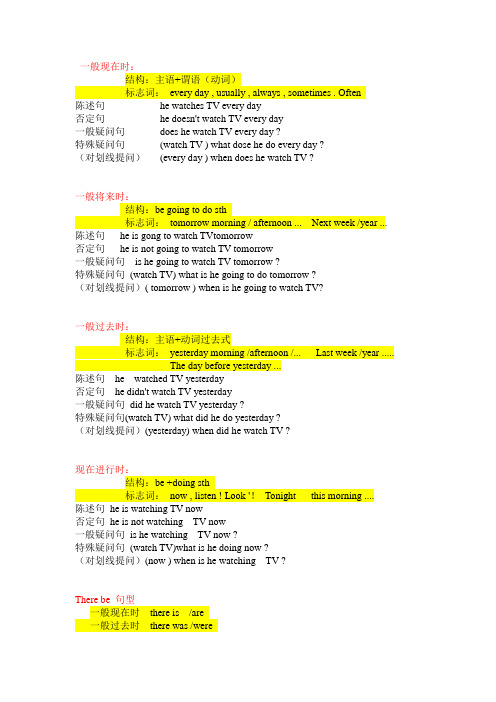
一般现在时:结构:主语+谓语(动词)标志词:every day , usually , always , sometimes . Often陈述句he watches TV every day否定句he doesn't watch TV every day一般疑问句does he watch TV every day ?特殊疑问句(watch TV ) what dose he do every day ?(对划线提问)(every day ) when does he watch TV ?一般将来时:结构:be going to do sth标志词:tomorrow morning / afternoon ... Next week /year ... 陈述句he is gong to watch TVtomorrow否定句he is not going to watch TV tomorrow一般疑问句is he going to watch TV tomorrow ?特殊疑问句(watch TV) what is he going to do tomorrow ?(对划线提问)( tomorrow ) when is he going to watch TV?一般过去时:结构:主语+动词过去式标志词:yesterday morning /afternoon /... Last week /year .....The day before yesterday ...陈述句he watched TV yesterday否定句he didn't watch TV yesterday一般疑问句did he watch TV yesterday ?特殊疑问句(watch TV) what did he do yesterday ?(对划线提问)(yesterday) when did he watch TV ?现在进行时:结构:be +doing sth标志词:now , listen ! Look '!Tonight this morning ....陈述句he is watching TV now否定句he is not watching TV now一般疑问句is he watching TV now ?特殊疑问句(watch TV)what is he doing now ?(对划线提问)(now ) when is he watching TV ?There be 句型一般现在时there is /are一般过去时there was /were一般将来时there is /are going to bethere is /was +可数名词单数、不可数名词There are /were + 可数名词复数陈述句there is a book on the desk否定句there is not a book on the desk一般疑问句is there a book on the desk ?特殊疑问句(a book ) what is on the desk ?(对划线提问)(on the desk ) where is the book?情态动词:can /must/should /shall/may /might/could + 动词原形陈述句he can sing否定句he can't sing一般疑问句can he sing ?特殊疑问句(sing ) what can he do ?(对划线提问)。
新概念英语时态表格
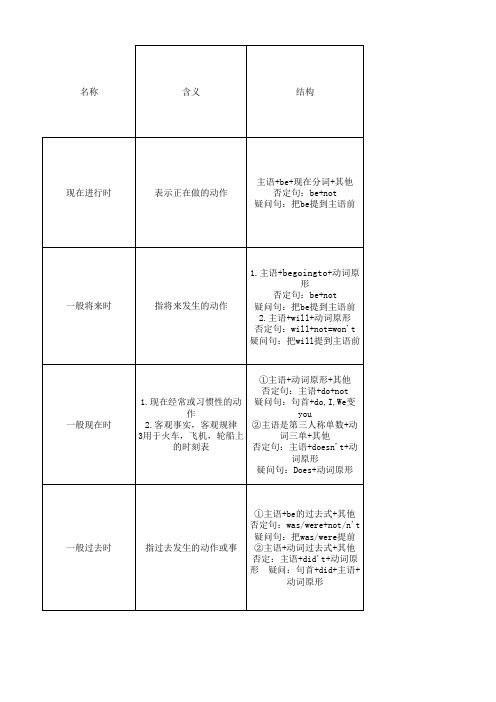
be的过去式:am/is--was are——were 过去式变化:①+ed:1.|t|遇 到清辅音2.|d|遇到元音与浊 辅音 3.|id|遇到t、d字母 ②以e结尾+d live--lived ③辅音字母+y把y变i+ed ④双写结尾辅+ed (stop.plan) 不规则变化:1.go--went 2.do--did 3.see--saw 4.sit--sat 5.fly--flaw
1.用于when引导的时间状语从 句从句用一般过去时,主句用 过去完成时(主句的动作在从 句之前发生) by或by the end of+过去时 2.用于before引导的时间状语 间(截止到„为止或到„为 从句:从句用一过,主句用过 止) 完 3.用于after引导的时 间状语从句:从句用过完,主 句用一过。
动词三单:①直接加s ②以s,ch,sh,o结尾+es ③以辅音字母+y结尾,把y变 i+es fly -- flies ④特殊变化 have--has
everyday 每天 often 经常 always 总是,一直 usually 通常 sometimes 有时 never 从不,绝不(否定) seldom 很少(否定)
yesterday (昨天) last短语 (最后) „„ a go („„以前) in+过去时间
过去分词变化:①规则变化 1.already(只用于肯定句, =过去式(+ed ) 放在have/has与过去分词之 ②不规则变化:1.go--gone 间 2.do--done 3.see--seen yet(用于否定、疑问句, 4.have--had 5.be--been 放句末尾)just刚刚 (含义②与时状②要求的动词 before之前 ever曾经 必须为可延续性动词,下列动 2.for+一段时间 词遇时状②转换)go、come-- since+过去时间(用howlong提 问) been in the past+一段时间 leave--been away buy--had so far=up to now=up till begin--been on now borrow/lend--kept 运用含义2:在when与while引 导的时间状语从句中,when作 为当„的时候,while作为与 at+点钟+过去时间 „同时/当„的时候 this time+过去时间 when:一个句子的动作为一 (过去的这段时间 过,另一个句子的动作与它同 at that moment=then 时发生,就用过去进行时。 at that time(在那时) While:前后时态都用进行时 (瞬间性动词除外)
新概念英语语法:英语时态例句和用法表

新概念英语语法:All Tenses 时态(共16种):一般时: 现在 The Present Indefinite/. 过去 The Simple Past Tense . 将来 The Simple Future Tense过去将来现在 进行时 The Present Continuous Tense过去 Past Continuous Tense将来 The Future Continuous Tense过去将来现在 完成时 The Present Perfect Tense 过去 The Past Perfect Tense将来 The Future Perfect Tense 过去将来过去 完成进行时 现在 将来 过 去 >> 现 在 >> 将 来 >>过去将来 >>动词时态的构成 (主动形式)时态的构成例句( 分别以I, He 为主语和sit, do 为谓语动词为例)现 在 过 去 将 来 过 去 将 来 一般 I sitHe does.I sat He did I shall sit He will do I should sit He would do完成 I have sat He has done I had sat He had done I shall have sat He will have done I should have sat He would have done 进行 I am sitting He is doingI was sitting He was doingI shall be sitting He will be doingI Should be sitting He would be doing完成进行I have been sitting He has been doing I Had been sitting He had been doingI shall have been sitting He will have been doingI should have been sitting He would have been doing动词时态的被动形式(Passive Voice )的构成: (共10种时态有被动形式)现在过去将来过去将来一般时 I sitI satI shall sitI should sit进行时 I am sitting I was sitting I shall be sitting I should be sitting. 完成时 I have satI had satI shall have satI should have sat完成进行时I have been sittingI had been sittingI shall have been sittingI should have been sitting现在过去将来过去将来一般时am (is; are )given was/were given shall/will be given should/would be given 进行时am( are; is ) being given Was/were being give n / /完成时Have(has) been given Had been given Shall/will have been given Would have been given时态构成常连用的时间状语用法及例句一般现在时do /does(动词原形, 第三人称单数词尾加-s)every …,sometimes,at …,on Sundayalways,often,usually,1.表示经常性或习惯性的动作。
- 1、下载文档前请自行甄别文档内容的完整性,平台不提供额外的编辑、内容补充、找答案等附加服务。
- 2、"仅部分预览"的文档,不可在线预览部分如存在完整性等问题,可反馈申请退款(可完整预览的文档不适用该条件!)。
- 3、如文档侵犯您的权益,请联系客服反馈,我们会尽快为您处理(人工客服工作时间:9:00-18:30)。
第八章时态8.1概说8.2 一般现在时(II_2,II_26,II_50)一般现在时可用于陈述现在时间内发生或存在的事件、动作或情况。
这些事件、动作或情况也可能会无限期地延续下去。
一般来说一般现在时可用于以下几种情况:1>一般现在时可用于现阶段内发生的情况E.g:My father works in school.My sister wears glasses.No two sorts of birds practisequite the same sort of flight.没有任何两种鸟飞行方式相同的。
2>表示习惯性的动作,通常表示不断重复的动作,时间状语可带可不带。
E.g:She gets up at 7:00. (即天天如此)John smokes a lot.当使用频度副词,如always, never, usually, rarely, sometimes或副词短语every day, every week 时,这种现在时可使习惯动作表现得更加明显。
She visits her parents every day.Cats never fail to fascinate human beings.Sometimes the secrecy goes to such an extent that the whole nature of the research cannot be mentioned.有时,保密竟达到这样的程度,即连研究工作的整个性质都不准提及。
----How often do you go to the dentist?----I go every six months.----Do you ever eat meat? (你经常吃肉吗?)----No, I never eat meat.3>一般现在时可以用来表示现在的特征或状态E.g:I am an art student and I paint a lot of pictures.(目前状态)它也经常用于表述经常性或习惯性的动作,或带有普遍性的情况,频度副词可有可无。
Many people pretend that they understand modern art.(普遍情况)They always tell you what the picture is “about”.(经常性动作,有频度副词)4>表示客观真理、科学原理、自然现象,等客观事实或格言、谚语E.g:Tomorrow is Tuesday.Waters boils at 100℃. (100℃读:one hundred degrees centigrade)The earth moves round the sun.The sun rises in the east and sets in the west every day.Summer follows spring.春去夏来。
5>当谈论的是关于时间表、节目单或日程表上所安排好的事情的时候,通常用现在时表示将来意义。
(用现在时表示将来时间,再其它情况也会出现,注意总结)E.g:The exhibition opens on January 1st and closes on January 31st.We leave tomorrow at 11:00 and arrive at 17:50.6>表示现在瞬间一般现在时可以用来描述动作的完成与说话的时间几乎是同时的这种情况。
常用于体育运动的实况报道、戏法表演、技术操作表演等的解说词。
E.g:Demonstrator(示范者):Now I put the cake mixture into this bowl and add a drop of vanilla essence.I declare the meeting opens.Now, look, I open the box.7>表示状态和感觉的动词通常用于一般现在时。
如appear, appreciate, be , believe,notice, feel, find, forget, resemble, hear, know, like, look like , remember, see, think, understand. 这些动词一般不用于进行时。
----I think they are watching TV.----I’m sure they are, They often watch TV.I can’t understand this picture. 我看不懂这副画。
Can you see any mistake? 你发现任何错误了吗?另外有些表示所属关系以及喜好、憎恶、需要等感情的动词通常也只用于现在时而不用于进行时。
这些动词包括belong to, consist of, contain, desire, detest, dislike, hate, hope, love, matter, mean, mind, need, want, wish等,它们往往表示通常的状态而不是动作。
(参见II_50)(个人注:其实这里说明了一般现在时更加强调的是通常的状态,而现在进行时更加强调的是动作)E.g:The car belongs to Dan. (不可用于进行时)I need a new hat. (表示状态)----Listen to him! He’s singing a pop song.听!他正在唱一首流行歌曲。
(具体动作)----I refuse to listen to anyone who sings pop songs.我拒绝听任何人唱流行歌曲。
(通常的状态,用一般现在时)----Why are you drinking tea? Why do you drink coffee?你为什么在喝茶?为什么不喝咖啡呢?(当时的动作)----I prefer tea.我喜欢茶。
(通常的状态)----Why is she wearing that dress?----I expect she likes it.我想她喜欢它。
(expect在这里相当于think,不能用进行时;like表示通常的状态) ----Has n’t she phoned you yet?她还没给你打电话吗?----No, but I’m expecting her to phone any minute now.没有,不过她现在随时可能打来电话。
(expect在这里相当于行为动词wait,所以用进行时态)8.3 一般过去时一般过去时通常表示过去发生的而现在已经结束的事件、动作或情况。
它通常指动作何时发生,而不指动作持续多久。
因此,过去时与表明事情发生的状语连用是非常重要的。
1>一般过去时通常表示过去某一时间发生的而现在已经结束的动作、事情或状态,常和表示过去某一时间的状语just now, yesterday, at that time, three yearsago, recently等连用E.g:Six hundred years ago, Sir John Hawkwood arrived in Italy with a band of soldiers and settled near Florence.(III_14_P66)----Do you ever catch a cold in the winter?----Yes, I caught a cold last winter.一般过去时通常和表示过去的时间连用,有时没有具体的过去时间,需要通过上下文判断时间。
I travelled to the Portsmouth by bus yesterday. I got on the bus and sat down.由于一般过去时常常表示过去某个特定的时间发生的事件,因此,它常与when, where等疑问连词连用。
除了时间状语可以表示特定的时间之外,地点状语也可以暗示或包括特定的时间。
E.g:----Where did you lose your money?----I lost it at the office last week.Where did you last see her?----When did you paint the picture?----I painted it last year.2>在一段文字中,初次使用一般过去时的时候通常要有明确的时间状语,随后的叙述则可以不一定使用时间状语;如果不加before, after等词语,过去的动作就被认为是按所描述的顺序发生的。
E.g:One afternoon she set out from the coast in a small boat and was caught ina storm. Towards evening, the boat struck a rock and the girl jumped into thesea.一天下午,她乘小船从海岸出发,遇上了风暴。
天将黑时,小船撞在了一块礁石上,姑娘跳进了海里。
----Did you use your bicycle last week?----Yes, I cleaned it first and then I used it.3>时间状语从句可以起到描述过去时间背景的作用。
When the article arrived, the editor read the first sentence and then refused to publish it.(III-5_P30)4>一般过去时与一般现在时在上下文中同时使用可以表示对比(II_27).E.g:----He always enjoys meals.(他总是胃口很好)----No, dose he ? He didn’t enjoy meals yesterday.----he did n’t remember her name just now.----Oh, didn’t he ? I thought he always remembered names.噢,是吗?我原来认为他总能记住名字的。
(言外之意是我现在不这么认为了)一般过去时可以用于与最近的打算比较(II_51)----Are they going to see a film?----I don’t expect so. They saw one last week.一般过去时可以用于与最近的打算比较时----Are they going to see a film?----I don’t expect so. They saw one last week.5>若所给信息影响了时间限定,则必须给出时间状语E.g:I received the magazine I ordered last week.6> once和recently常用于一般过去时----He changed the job, didn’t he?----Yes, he did. His wife wanted him to.I went on an excursion recently.最近我作了一次短途旅行。
